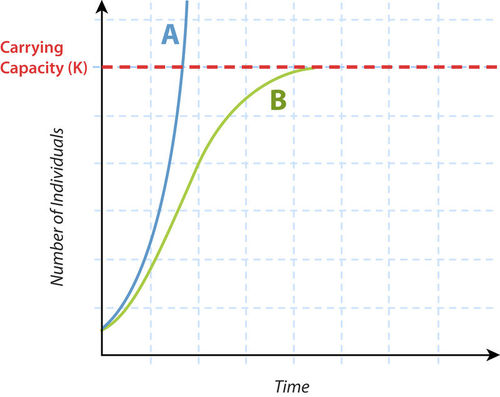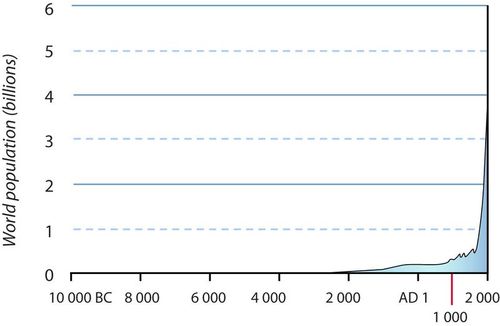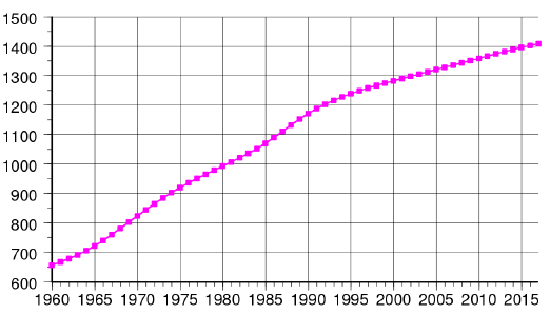what would happen to a population whose birth rate is equal to death rate
four.2: Population Dynamics
- Page ID
- 32485
Population growth refers to changes in population size over fourth dimension. Figure \(\PageIndex{one}\) illustrates one way that populations abound: adding babies through births. Tin can yous think of other means that populations change in size in a given area?

Patterns of Population Growth
Populations are dynamic. They are continuously gaining individuals through births and losing individuals through deaths. Populations may also gain or lose a significant number of individuals through migration when people either enter or leave a population. All of these factors together determine whether and how apace a population grows. Population growth rates may modify over time. Two well-studied patterns of alter in population growth rates are exponential and logistic growth.
Exponential and Logistic Growth

Nether ideal atmospheric condition, populations of almost species, including Homo sapiens, take the potential for exponential growth, represented by curve A in Figure \(\PageIndex{2}\). With exponential growth, the population starts out growing slowly, merely as population size increases, the growth rate also increases. The larger the population becomes, the more rapidly it grows.
Almost no populations live under ideal conditions. Therefore, most do not abound exponentially, at to the lowest degree non indefinitely. They may first outgrowing exponentially, but sooner or later on, something will limit their growth. Many factors may limit population growth so information technology slows down or even stops. Often, the factors are density-dependent. Density-dependent factors are those that cause population growth to slow down when the population becomes likewise large and crowded. For example, the population may start to run out of food, or crowding may lead to communicable diseases epidemics. More deaths may occur or more people may emigrate, causing population growth to wearisome and population size to level off. Curve B inFigure \(\PageIndex{2}\) represents this design of growth, which is called logistic growth.
At what size does a population cease growing in the logistic growth pattern? That depends on the population's carrying capacity (Figure \(\PageIndex{2}\)). The conveying capacity (K) is the largest population size that can be supported by available resources without harming the environment. Population growth hits a ceiling at that size in the logistic growth model.
Exponential Growth of the Human Population
For most of our species' existence, the global population grew very slowly. Then, starting a few centuries ago, the human population started to grow exponentially. You can see this clearly in the graph in Figure \(\PageIndex{three}\). It took the human being population many millennia to attain 1 billion people, which occurred around 1800 CE. Subsequently that, it took simply a petty over a century for the number to reach ii billion. In less than another century, nosotros added another 5 billion people, reaching a total of seven billion people past 2012. Today, the human population is rapidly budgeted the eight billion mark. At a global growth charge per unit of 1.03 percent in 2021, we are calculation a internet number of more than than fourscore million people each year. If that growth rate were to go along, the total human population would double in just 58 years.

Is it possible for the human population to keep growing at ane.two percent? The late-xviiith century economist Thomas Malthus predicted that the continued rapid growth of the human population would shortly outstrip food product, leading to increasing dearth and college death rates. This would be evidence that the population had reached its carrying chapters and could no longer keep growing. Unless population growth was reigned in before the carrying chapters was reached, Malthus argued, there would be a population crash caused past heightened warfare, malnutrition, and disease.
Overpopulation
Since Malthus fabricated his dire alert, the man population has grown from just nether a billion to more than 7 billion people. Has the human population already reached or surpassed its carrying chapters? Is the planet overpopulated with people? Do we have a homo overpopulation problem?
Human Carrying Chapters
Attempts to summate the conveying capacity for the global human population have produced widely varying estimates. Withal, a meta-assay of 69 such studies concluded that the best guess of the human carrying capacity is 7.7 billion people. The human population is projected to reach 10.88 billion people by the year 2100. If these estimates are correct, it suggests that the man population is at the tipping bespeak and must stop growing. Some human being populations already suffer shortages of food, water, and other resource; and our use and acquisition of resources accept already damaged the environs. Such prove suggests that we accept reached our carrying chapters and there actually is an overpopulation problem.
Not Just Overpopulation
Although many environmental problems are aggravated by the size of the human being population, some experts think that over-consumption and waste by populations in wealthy nations are worse issues than sheer human population numbers. People in the more than-adult nations utilize resources at a rate more than than thirty times greater than the charge per unit in less-adult nations, where the majority of people live today. If anybody used resource at the rate of people in developed countries, the full human population would need more than one planet Earth to supply their demands. Reducing profligate consumption of resource and our ecological footprint are clearly needed to help solve the overpopulation trouble.
Slowing Human Population Growth
Environmental problems are not caused solely past human overpopulation. However, having then many people on the planet certainly makes problems worse, so it is important to reduce the rate of human population growth. A widely accustomed goal is an overall zero growth charge per unit for the man population. Zero population growth (ZPG) occurs when the nascency rate equals the expiry rate (assuming no cyberspace migration for the man population as a whole). ZPG can exist accomplished if women average only enough children to replace themselves and their partners in the population. This is called the replacement fertility charge per unit. It ranges from simply over ii to almost three children per woman, depending on the death rate. At a higher expiry rate, the replacement fertility charge per unit is higher considering fewer children survive to adulthood to supplant their parents in the population. Even if the fertility rate falls to the replacement level, however, there will still be a time lag before the population growth charge per unit levels off. That's considering populations that have recently had high birth rates accept a youthful age distribution, with a large proportion of women at peak childbearing ages. With then many young women, the population birth rate will remain high for at least some other generation.

Childbearing is a deeply important and personal decision that is influenced by many socioeconomic and cultural factors. Obviously, trying to influence how many children women accept is a complex problem. A meridian-downward approach was instituted in Mainland china in 1979 when information technology enacted a one-kid-per-woman policy. The Chinese government has credited the policy with reducing Prc's population past 400 million people. However, China'due south fertility charge per unit was already falling when the policy was put into effect, and so the impact of the policy is disputed. The bodily growth of the Chinese population is shown in the graph in Figure \(\PageIndex{four}\). The tiny dip in the curve starting around 1979 suggests the policy'south impact on population growth was minimal.
Unlike in China, most countries do not take direct policies to limit fertility rates. However, evidence from many populations shows that women kickoff having fewer children when there are more educational and economic opportunities for females, advances in gender equality, greater cognition of family unit planning, and better access to contraception. Needless to say, such society-broad changes are often very hard to achieve and require multiple approaches, merely the time to come of our species may depend on them.
Feature: Human Biological science in the News
Just days into his presidency on January 23, 2017, and surrounded solely by male members of his assistants, President Donald Trump signed an executive order reinstating the and so-called "Mexico City Policy." This policy too referred to as the "global gag dominion," was first put into event past President Ronald Reagan in 1984. The policy withholds U.S. authorities funding from whatsoever international non-governmental organization that performs or promotes abortions as a family planning option. The Mexico Metropolis Policy was rescinded by the Clinton Assistants in 1993, reinstated by the Bush Administration in 2001, and rescinded again past the Obama Administration in 2009.
While Trump's reinstatement of the United mexican states City Policy was praised by Republican politicians and anti-abortion activists, Democratic politicians and abortion-rights activists reacted to it with newsworthy alarm. They called the reinstatement a "ending" for women in less-developed countries, arguing that information technology volition lead to large increases in unintended pregnancies, dangerous abortions, and neonatal and maternal deaths.
The United mexican states City Policy shows how politically charged the control of fertility tin be. However, promoting family planning in high-fertility populations is an important function of the solution to the overpopulation problem. Unless fertility is reduced to replacement levels, human populations will continue to grow.
Review
- Why are populations dynamic?
- What factors decide the growth rate of the man population?
- Describe variation in recent human population growth rates.
- Compare and dissimilarity exponential and logistic patterns of population growth.
- Ascertain carrying capacity.
- Briefly summarize how the population of the homo species has grown.
- Hash out evidence for and concerns about man overpopulation.
- Define the replacement fertility rate, and explain why information technology depends on the death rate.
- Assuming the expiry charge per unit remains constant, why is there a time lag between a decrease in fertility and the slowing of population growth?
- Identify bear witness-based factors that lead to fertility decline.
Explore More
fairbanksmandiess.blogspot.com
Source: https://bio.libretexts.org/Courses/Monterey_Peninsula_College/MPC_Environmental_Science/04:_Populations/4.02:_Population_Dynamics

Belum ada Komentar untuk "what would happen to a population whose birth rate is equal to death rate"
Posting Komentar